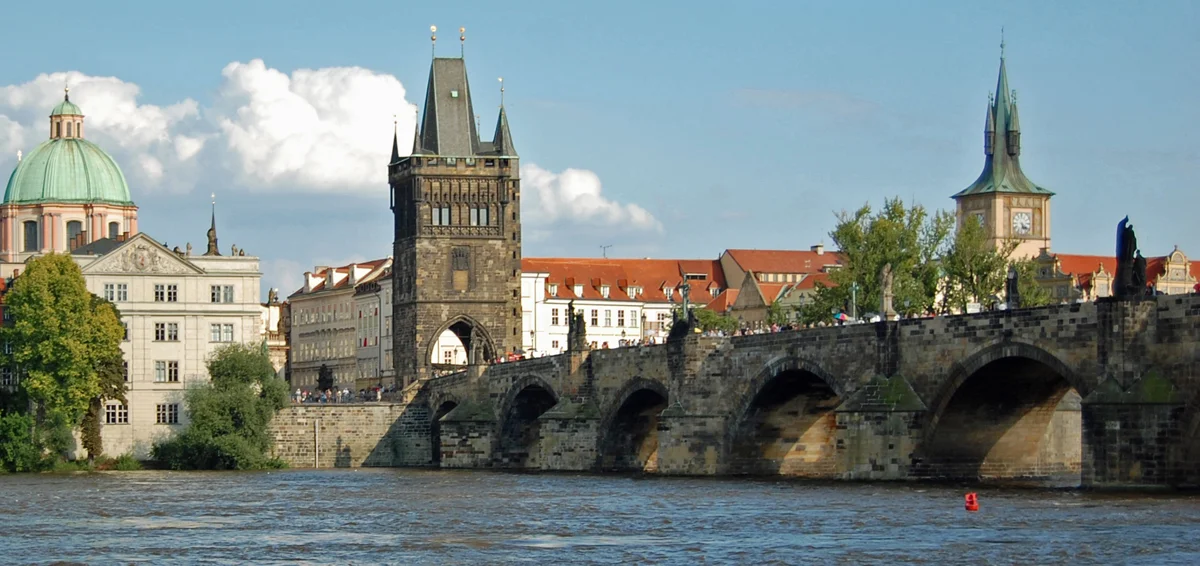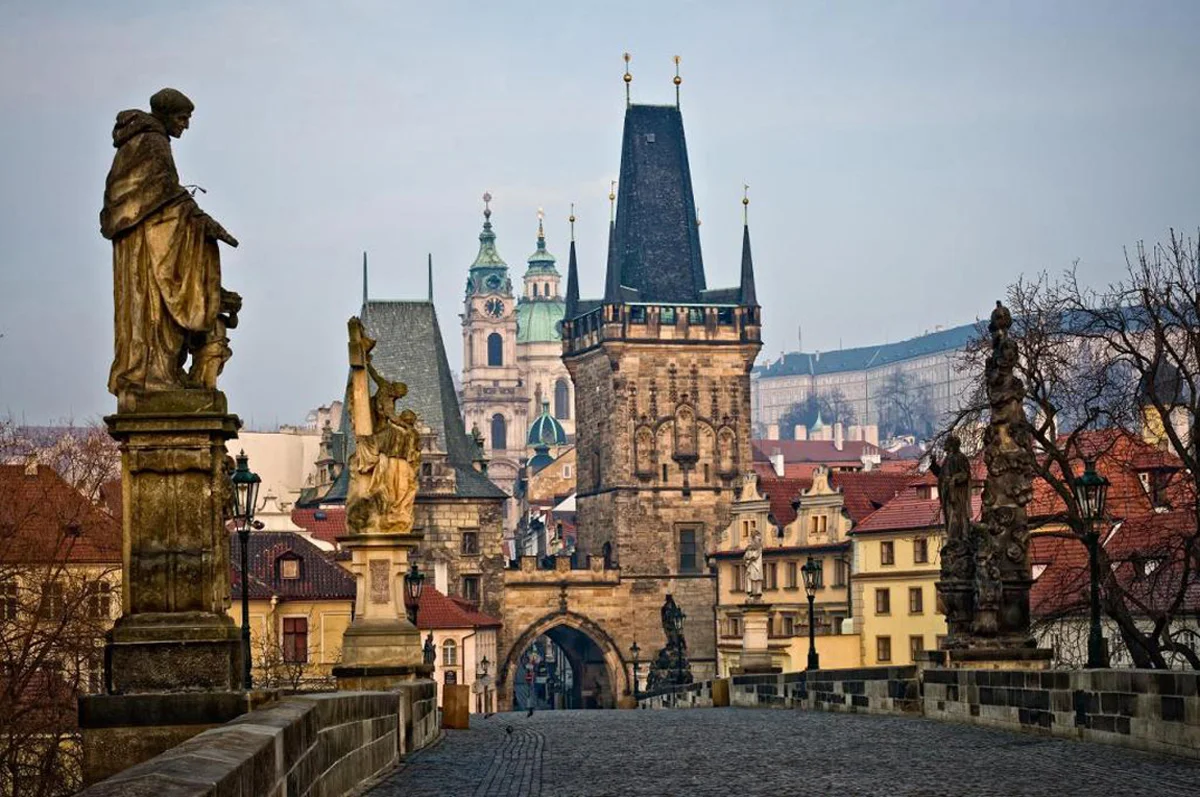Charles Bridge (Karlův most) on the Vltava River is located in the historical part of Prague: it connects Stare Mesto and Mala Strana - the medieval districts of the Czech capital. The powerful half-kilometer structure with heavy arches and bronze statues of Catholic saints is always filled with tourists. Here you can make a wish, buy souvenirs from local artists and admire the views of the river and coastal neighborhoods from the observation decks on the bridge towers.
 |
| Charles Bridge Prague |
It may be the most famous architectural landmark in Prague. The Charles Bridge is a true icon of the Czech capital, the stamp that every traveler wants to take home from his visit to this city. Whether by day, at dusk or at night, the Charles Bridge offers the visitor a unique image.
The Charles Bridge is the oldest in Prague, linking the Old Town (Staré Město) with the Malá Strana district, where the Prague Castle is located. It was built between 1357 and 1402, and it was the only viaduct in the city that crossed the Vltava River. It is considered one of the most important Gothic structures in the world.
 |
| Charles Bridge Prague |
Strolling across the Charles Bridge is a magical moment. By day, it is like visiting a monument. Its characteristics make it a masterpiece that deserves to be observed calmly. At night, it is crossing the river between romantic airs. The destination, always, the Malá Strana neighborhood (“Little Town”), that bohemian and palatial area of the Czech capital.
The bridge takes its name in honor of King Carlos IV, who was in power during its construction. Charles I of Bohemia and IV of Germany was emperor of the Holy Roman Empire, of which the current Czech Republic was a part, between 1355 and 1378.
The Charles Bridge in Prague and its sculptures
If there is something that characterizes the Charles Bridge in Prague, it is its statues. Its more than 500 meters in length are dotted, on both sides, by some thirty sculptures that give status to the walk between both sides of the city.
 |
| Charles Bridge Prague |
The images are replicas of those placed in the late seventeenth and early eighteenth centuries, and represent various relevant saints of the time. The most famous is that of San Juan Nepomuceno, Czech saint and patron of the Spanish Navy Infantry, who was thrown into the river by order of Wenceslas IV in 1393. A brass cross on the railing marks the place where the saint was thrown off. Many people make a wish by placing their left hand on the statue. There are also those who touch the dog at the base, a symbol of fidelity, to promise to return to Prague in the future.
Besides San Juan, some statues are really spectacular. For example, the Crucifixion, from the 17th century, a bronze crucifix that replaces earlier wooden versions. Also impressive is the sculpture of San Juan de Mata, Félix de Valois and Blessed Iván, the largest on the bridge, at the base of which there is a small cavity where three chained Christians hide.
Another of the most famous and important statues from the artistic point of view is that of Santa Luitgarda. This blind nun had a dream in which Jesus bowed down to her to kiss her wounds.
 |
| Charles Bridge Prague |
The bridge towers
In addition to the statues, the other great feature of the Charles Bridge are the three defensive towers that served as gates at both ends of it, on both banks of the Vltava River.
The tower on the side of the old city was built in the 14th century, in the time of Charles IV, as was the bridge. On the other side, the Malá Strana Tower was built in the 15th century and connects with the neighboring 12th-century Judith Tower through an archway. Judith's tower belongs to the bridge before Charles's, which was knocked down after a flood in the Vltava River.
It is possible to climb to the top of the towers, from which you get a magnificent view of the river as it passes through Prague.
History of the most famous bridge in Prague
The Charles Bridge came to solve a problem that clung to the Vltava River. The floods destroyed the then Judith Bridge and the two parts of Prague were cut off from each other. The existence of a communication channel at this point dates back centuries. Already in the 10th century there was a wooden bridge that connected both banks, until it was replaced by the Judith Bridge in the 12th century.
It was King Charles IV who decided to raise the bridge that has survived to this day, again linking the castle and Malá Strana with the Old City. The architect was Petr Parler, who designed the Powder Tower and participated in the construction of St. Vitus Cathedral. Parler raised a Bohemian sandstone bridge, 520 meters long and supported on 16 arches. In fact, the viaduct was originally called Puente de Piedra, until in 1870 it was baptized with the monarch's name.
 |
| Charles Bridge Prague |
For several centuries, the bridge had a toll for those who wanted to cross it. The proceeds were used to maintain the infrastructure itself. Already at the end of the 20th century it was closed to road traffic and since then it is only pedestrianized.
The Charles IV Bridge, at night
This is how the Charles Bridge arrives in the 21st century. Protected, but not exempt from further suffering from the strong currents of the Vltava. A symbol of Prague that transforms at night. Walking at night on the Charles Bridge is an experience for the senses. The exquisite lighting of the towers, the castle as a backdrop, the enchantment of the river and the accompaniment of the musicians that are spread throughout the area, are the perfect ingredients for a magical evening.
Prague at night deserves to be experienced. And the night of Prague, too. Around the Charles Bridge there are several emblematic places of the nightlife of the Czech capital. Practically at the foot of the bridge is Karlovy Lázně, a five-story nightclub considered the largest in Central Europe. Next to it, one of the famous Ice Pub (ice bar). And at the beginning of Karlova Street, which leaves the bridge in the direction of the Old Town Square, is the Golden Tree Prague, another large three-story nightclub. In short, three temples of the Prague night at the foot of the Charles Bridge.